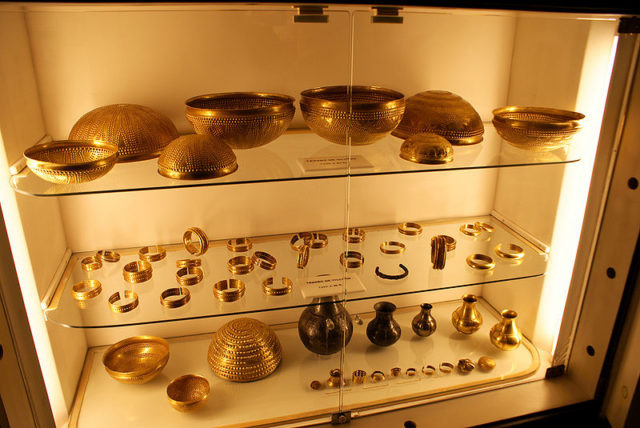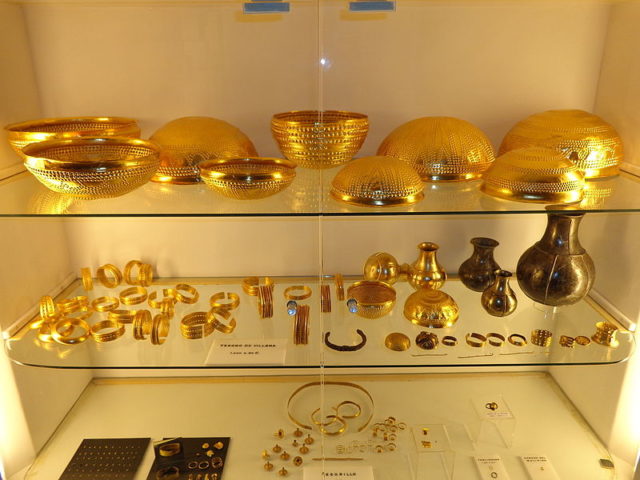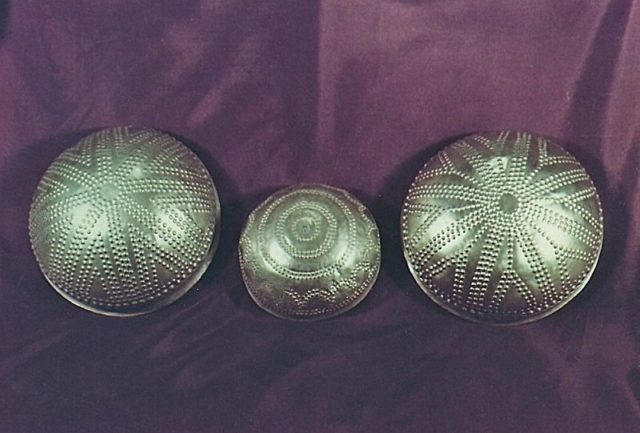In December 1963, the once-flowing river near Villena, Spain, dried up, unveiling a hidden treasure trove that has since become one of the most significant archaeological finds in Europe. Unearthed by Spanish archaeologist José María García Soler in the dry riverbed known as the “Rambla del Panadero,” the Villena’s Treasure comprises nearly 10 tons of artifacts dating back to about 1000 BC. This remarkable discovery ranks as the second most important treasure found in Europe, with the Royal Graves in Mycenae, Greece, being the only rival.
The Composition of Villena’s Treasure:

It was found inside a Bronze Age vessel. Photo Credit

The gold pieces include eleven bowls, three bottles, and 28 bracelets. Photo Credit
The hoard, enclosed in a Bronze Age vessel, consists of 59 objects made from gold, silver, iron, and amber, collectively weighing 9,754 kilograms. The collection includes eleven gold bowls, three bottles, and 28 bracelets, each varying in size, weight, and decoration. These artifacts provide a fascinating glimpse into the craftsmanship and artistry of an ancient civilization.
The Mystery Surrounding Villena’s Treasure:

Despite its historical significance, the origin and purpose of Villena’s Treasure remain shrouded in mystery. The pieces’ discovery garnered international attention, with media coverage in Spain, France, Germany, and the United States. However, the circumstances of how these artifacts ended up in Villena, who created them, and their original purpose remain unknown, fueling intense debate and speculation among archaeologists and historians.
Interpretations of Villena’s Treasure:

There is a total of 28 bracelets with different sizes, weights, and decorations. Photo Credit

Bracelet number 29, the most complex part of the whole. Photo Credit
With no definitive answers regarding its origins, Villena’s Treasure has been subject to various interpretations. Some experts suggest it may have served as a religious offering, while others propose that it symbolically delineated territory. The absence of concrete information has led to a range of theories, sparking ongoing discussions within the archaeological community.
Public Exhibitions and Conservation:

Two jars of gold and silver (items 41, 43 and 42). Photo Credit

Supposedly the remains of a scepter or sword. Photo Credit
Villena’s Treasure has not only captured the imagination of scholars but has also been showcased in various exhibitions worldwide. The artifacts have been displayed in Madrid, Alicante, Tokyo, and Kyoto, allowing people from different corners of the globe to marvel at the ancient craftsmanship. Presently, two sets of copies of the entire treasure are exhibited while the originals are permanently preserved in an armored showcase at Villena’s Archaeological Museum.

Gold bowls. Photo Credit

The treasure has been differently interpreted, as a religious offering or a way to symbolically delimit the territory. Photo Credit

The most successful exhibit in Villena’s Archaeological Museum. Photo Credit
The accidental discovery of Villena’s Treasure in the dry riverbed near Villena stands as a testament to the rich history of the Iberian Peninsula. While the artifacts themselves offer a glimpse into the craftsmanship of an ancient civilization, the mystery surrounding their origin and purpose adds an air of intrigue to this remarkable find. Villena’s Treasure continues to be a source of fascination, prompting ongoing research and speculation that may one day unveil the secrets hidden within its golden embrace.